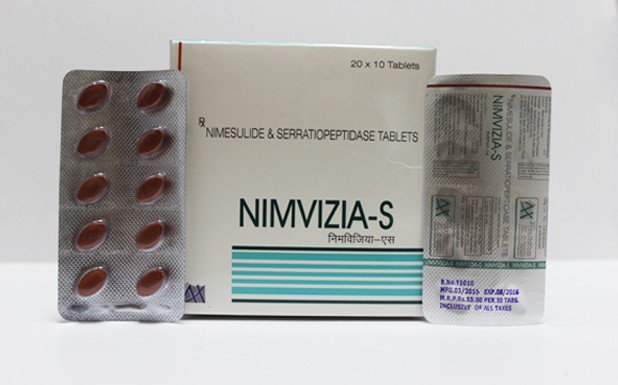
Composition
- Each Tablets Contains:
- Nimesulide
100 mg
- Serratiopeptidase
10 mg
Packing
- 20X10
(Blister)
MRP
- 55
Overview
Nimesulide is a non steroidal anti inflammatory (NSAID) which possesses analgesic and antipyretic properties. Nimesulide has superior gastrointestinal safety as compared to other NSAIDs .Its approved indications are the treatment of acute pain, the symptomatic treatment of osteoarthiritis and primary dysmennorhea.
Serratiopeptidase is a proteolytic enzyme (protease) produced by Enterobacterium Serratia sp. E-15 used in the prevention of pain and swelling.
Uses
NimesulideNimesulide has superior gastrointestinal safety as compared to other NSAIDs. Its multifactorial mode of action gives it a unique and broad action on inflammatory processes.
It has proven benefits in the treatment of Acute (short term) pain, Painful osteoarthritis (Swelling in the joints) and Primary dysmennorhea ( Period Pains).
Serratiopeptidase
Serratiopeptidase is an anti-inflammatory agent that can be used to pacify mild to moderate pain and inflammation. Common conditions associated with pain and inflammation include arthritis, trauma, surgery and fibermyalgia
Warnings
Usage in pregnancy and nursing mothers:
No well controlled studies are available regarding the use of nimesulide or Serratiopeptidase in pregnancy and lactation. Avoid the use of Nimesulide Serratiopeptidase in such cases.Usage in children:
Safety and efficacy of Nimesulide in children is well established.Contraindications
Hypersensitivity to Nimesulide and Serratiopeptidase. Nimesulide Serratiopeptidase is contraindicated in patients of active peptic ulcer disease, moderate to severe hepatic impairment, severe renal failure and with blood coagulation disorders.
Dosage
Oral:
Disclaimer:To be taken only after consulting with the doctor.
Pharmacology
Nimesulide
After oral administration of Nimesulide 50 to 200 mg to healthy adult volunteers, peak serum
concentrations of 1.98 to 9.85 mg/L are achieved within 1.22 to 3.17 hours. Oral drug
absorption is nearly complete and concomitant administration of food may decrease the rate,
but not the extent, of absorption of Nimesulide. The drug is extensively bound (99%) to
plasma proteins and has an estimated apparent volume of distribution of 0.19 to 0.35 L/kg
following oral administration. Nimesulide is extensively metabolised (1 to 3% of a dose is
excreted unchanged in the urine) to several metabolites which are excreted mainly in the
urine or the faeces. The drug is almost completely biotransformed into 4-
Hydroxy-Nimesulide in both free and conjugated forms and this metabolite appears to
contribute to the anti-inflammatory activity of the compound. Peak concentrations of 4-
Hydroxy-Nimesulide ranged from 0.84 to 3.03 mg/L and were attained within 2.61 to 5.33
hours after oral administration of Nimesulide 50 to 200 mg to healthy adult volunteers. The
elimination half-life of 4-Hydroxy-Nimesulide ranges from 2.89 to 4.78 hours and is generally
similar to or slightly higher than that of the parent compound (1.56 to 4.95 h).
The pharmacokinetic profile of Nimesulide is not significantly altered in children, elderly
volunteers and patients with moderately impaired renal function [creatinine clearance 1.8 to
4.8 L/h (30 to 80 ml/min)]. Slight accumulation of 4-Hydroxy-Nimesulide was noted in
patients with moderate renal impairment; however, the clinical significance of this finding is
unknown.
Serratiopeptidase
Serratiopeptidase when consumed in unprotected form is destroyed by acid in the stomach.
However, enteric coated granules, enable the enzyme to pass through the stomach
unchanged, and be absorbed in the intestine. It is found negligibly in urine suggesting that it
is transported directly from the intestine into the blood stream.
Interactions
Nimesulide: Due to the extensive plasma protein binding Nimesulide may be displaced from the binding site by concurrent administration of Fenofibrate, Salicylic acid, Valproic acid and Tolbutamide. Moreover, Nimesulide may displace Salicylic acid, Methotrexate and Furosemide from binding sites. Nimesulide reduced the diuretic effect for concomitantly administered Furosemide. Although Nimesulide does not appear to interact with Warfarin, in clinical practice, interaction with oral anticoagulants or other highly protein bound drugs cannot be ruled out. Nimesulide may cause enzymatic induction of Theophylline when administered concomitantly with it. Nimesulide had no significant effect on fasting blood and glucose tolerance in patients treated with anitdiabetic agents.Serratiopeptidase: With anticoagulative agents, it may increase anticoagulative effect and therefore Nimesulide Serratiopeptidase must not be used in such patients.